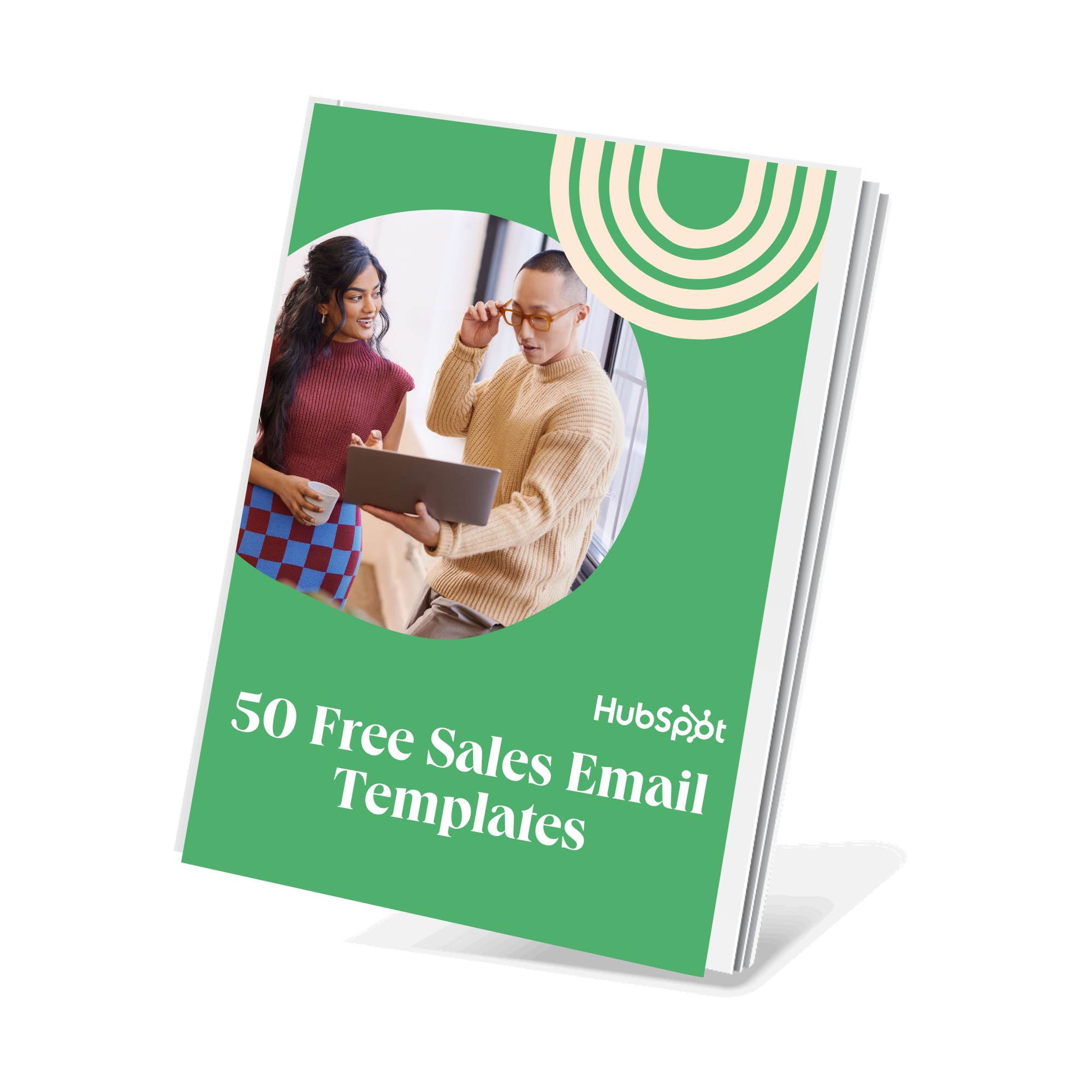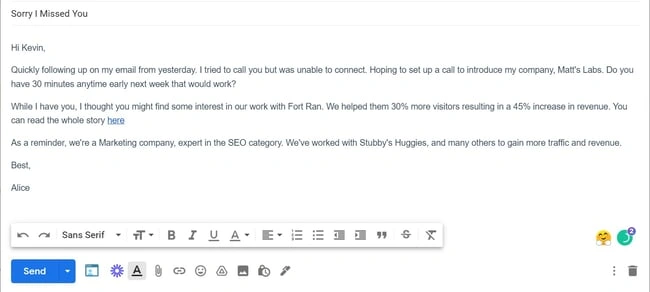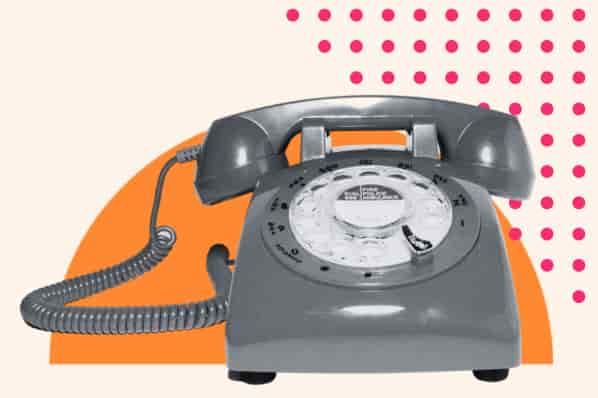I'm always saying, “Sound, well-structured business email templates are central to effective sales communication, initiating productive sales conversations, and sustaining relationships with prospects and customers.” Okay, maybe I'm not always saying that — nor have I ever actually said it word-for-word out loud — but it's still an important sentiment.

Business emails are a mission-critical component of virtually every step of the modern sales process, and it serves you to know how to send thoughtful, professional, approachable ones. Now at this point, you may be thinking, “My gosh! I totally understand how important these emails are, but I don't know where the heck to start with them!”
Well, reader who conveniently thinks of the questions I need to answer in this article, you‘re in luck! Here, we’ll cover what business emails are, the various types of business emails you should be sending, how to write business emails, and some examples and templates you can leverage as reference points.![Download Now: 50 Sales Email Templates [Free Access]](https://no-cache.hubspot.com/cta/default/53/be67aa79-8dbe-4938-8256-fdf195247a9c.png) Table of Contents
Table of Contents
- What is a business email?
- Types of Business Emails
- How to Write an Email to a Potential Customer
- Sample Business Introduction Letter to Prospective Clients
- Sample Email to Approach New Client
- Tips for Sending Proposal Emails to Clients
What is a business email?
Broadly speaking, a business email is any email sent in a professional context — specifically tailored to advance business interests with a prospect or customer. It's relatively self-explanatory.
When you dig a little deeper, the concept gets significantly more nuanced. The term “business interests” covers a lot of bases, so naturally, a business email can take on a lot of forms. I've sent business emails for everything from driving referrals to flexing my expertise for prospects to delivering cold pitches — along with a host of other purposes.
Let's get a little more perspective on the various kinds of business emails you can send.

50 Free Sales Email Templates
Save time, find new ways to reach out to prospects, and send emails that actually convert.
- First-Touch Emails
- Follow-Up Emails
- Break-Up Emails
- ChatGPT Email Prompts
Download Free
All fields are required.

Types of Business Emails
1. Proposal Emails
A proposal email can take on a lot of forms, but generally speaking, the term refers to an email that includes pertinent information, valuable context, and a persuasive edge — typically sent during the consideration or decision stage of the buyer's journey.
It‘s essentially a digital elevator pitch — a quick yet thoughtful rundown that sheds light on your value proposition and how your solution is specially equipped to suit your prospect’s needs and interests.
2. Prospecting Emails
Prospecting emails are business emails generally sent to warm or cold contacts to pique prospects‘ interests and get your foot in the door. They’re typically structured around some sort of value add and personal appeal.
That can be something like responding to a social post, commending a prospect on a recent achievement or career milestone, referencing a recent blog article they published, or any other avenue to frame yourself as an interested, consultative resource that they should consider doing business with.
Here's an example of what that might look like:

There are no shortcuts to writing great prospecting emails. A lot of your success will come down to testing different variations and structures to see what works for your audience and objectives. Use cold email templates to jumpstart this process.
3. Follow-up Emails
Follow-up emails are central to keeping prospects engaged, ensuring deals stay in motion, and in some cases, disqualifying uninterested prospects before you sink too much time and effort into your engagements with them.
They're typically sent following initial conversations, meetings, or proposals (shocking, I know.) Generally, they require a tactful balance of assertiveness and respect — you don‘t want to alienate prospects by being too aggressive, but you don’t want to let opportunities pass by being too “walking on eggshells-y” either.
4. Referral Request Emails
Happy customers are some of the most lucrative resources any sales org has at its disposal. According to HubSpot's 2024 State of Sales Report, 33% of sales professionals say that customer referrals are the best source for hig- quality leads — the highest percentage of any source.
Referral request emails provide an excellent opportunity to capitalize on the exceptional work you‘ve done to win a customer’s business — along with the effort your service and customer success teams put in to ensure that customer stays delighted.
How to Write an Email to a Potential Customer
- Spend some time on the subject line.
- Introduce yourself.
- Consider where they're at in the buyer's journey.
- Hone in on their pains and provide value.
- Push your value proposition.
- Conclude with a strong call to action.
1. Spend some time on the subject line.
According to Finances Online, 64% of recipients decide to open or delete emails based on subject lines — so how you structure your subject line is pretty high stakes when crafting business emails.
A solid subject line grabs a prospect and compels them to click and read further.
Here's what you should be doing if you want to write good email subject lines:
- Use personalization.
- Pose a compelling question.
- Use concise and action-oriented language.
- Leverage scarcity and exclusivity.
Check out our post about the best sales email subject lines if you want to see some of these tips in action.
2. Introduce yourself.
In my experience (and likely everyone else‘s) prospects are more inclined to open and engage with your email if they already know, like, and trust you. Unfortunately for us, many — if not most — prospects you send business emails to don’t know you intimately (or at all).
But hey, you have to start somewhere, right?
If a prospect has never received communication from you, give them a little context — but don‘t be too stiff and borderline robotic. People are more receptive to warm, authentic communication, so make sure you’re able to convey your warmness and authenticity (within reason).
Convey who you are and why they should listen to you, but also be sure to make it about them. For example, your email sales introduction could go something like this:
“My name is [Name], and I'm reaching out because ...”
Your next sentence could easily be a question to open a loop or a short elevator pitch to establish trust and authority.
3. Consider where they're at in the buyer's journey.
I, personally, wouldn‘t want to receive an email from a rep who’s trying to close before I‘ve even researched a solution — and I think everyone who has ever been on the buyer’s side of any sales communication can agree with that.
There‘s no point in selling yourself as a provider if your prospect hasn’t decided on a type of solution yet. This is where your CRM, a sales software solution, and their behavior on your website can be valuable tools.
If they've opted into consideration or decision stage content, you can ask them more pointed questions to drive them to a purchasing decision. However, suppose they've only opted into awareness stage content. In that case, it might help to take a more informational and educational approach because their behavior indicates they're not ready to make a decision yet.
4. Hone in on their pains and provide value.
A productive sales engagement doesn't revolve around cookie-cutter, one-size-fits-all sales communication. Prospects are individuals — with individual needs, interests, and preferences.
That means they have specific pain points, and if you want to appeal to them as effectively as possible, you need to zero in on those issues and speak to them directly.
No one wants to read a vague, generic sales email. They want to know what you can do for their business and the outcomes they can expect to see when they leverage your solution.
When you send a business email, aim to establish empathy and rapport by touching on their problems and the unique value you can offer them. For example:
“I see you host several campus events per year. I know it can be tough to get the students attentive and interested. I work with companies like Facebook and Google to help promote their college recruitment events.”
5. Push your value proposition.
This point is an extension of the last one — your understanding of your prospect's circumstances will help you shape a thoughtfully tailored, specific, compelling value proposition for your prospect.
If no one else in your space does it like you, say so, and provide social proof to back it up — this can come in the form of testimonials, case studies, or exciting statistics.
You need to pair a specific vision you have for their company with more general context of how you‘ve helped businesses like theirs. It can be hard for a prospect to just take the salesperson on the other side of a sales email at their word — so being able to point to bonafide evidence of your solution’s effectiveness can go a long way.
This helps them see your customer's success story and think, “If they could do it for them, they can do it for me.”
6. Conclude with a strong call to action.
Lastly, it’s important to include a strong closing line that nudges prospects to proceed to the next step, be it scheduling a call or simply replying with some questions. Jumping straight to your sign-off can sometimes feel anticlimactic and potentially confuse prospects.
That said, end on an intriguing note — think of something that would spark the prospect’s interest or subtly guide the customer into responding. For example, your closing line could look something like this:
“Let me know when as soon as you’re available, and I’ll schedule a call right away. Sounds good?”
Including links to your website or social media profiles within your email signature is also recommended. As I said earlier, people are more likely to engage with your email if they trust you — letting them verify your claims by checking your website or social accounts helps with just that.

50 Free Sales Email Templates
Save time, find new ways to reach out to prospects, and send emails that actually convert.
- First-Touch Emails
- Follow-Up Emails
- Break-Up Emails
- ChatGPT Email Prompts
Download Free
All fields are required.

Sample Business Introduction Letter to Prospective Clients
Here are several examples that can inspire your own prospecting techniques.
A couple of caveats:
- These are generalized to a greater degree than emails we would typically send; they apply to all types of companies and categories. (I've given you some examples of different languages you can use as a guide.)
- You can certainly get more creative than the email examples below, but be careful. That can backfire if you get too cutesy or familiar. You can pair email design templates with content to customize and build emails that stand out, delight your clients, and gets you the results you’re looking for.
1. Landing the First Meeting: Introduction Email to Potential Clients
This email would be used as an initial introduction to your company. The key is immediately establishing your expertise and asking for the meeting reasonably early.
Hi [Prospect],
[Your name] with [your company]. We're a Y company specializing in [choose either your primary vertical or a vertical you have experience in] to [insert a typical challenge you help clients face].
I'm wondering if you might be open to an initial conversation to gauge a fit.
We've worked with companies like [insert 2-3 clients here relative to the vertical] to [insert a typical client goal].
If you have a minute or two to learn more about us, you can visit us here at [site]. If I don't hear from you, I will reach out to you via phone later in the week.
Thank you,
[Your Name]

Why It Works
This email works because it’s direct and straight to the point. The second paragraph tells them why you’ll be valuable to them, which is great because most people don’t have time to go through a long essay.
2. Landing the First Meeting: Follow-Up Email
If you‘ve been referred to a prospect, use this template to make that connection. The great part is that you’ll have a warm start to building rapport.
Hi [first name],
I hope this email finds you well! [Mutual connection] suggested that I reach out to you because we both share a common [interest, industry, pain point].
I took a look at your business and noticed that [personalized comment based on research]. I think we can offer some valuable insights and solutions to help you [business outcome].
Would you be open to setting up a call to discuss this further? I'm available [suggested dates and times] and would love to hear your thoughts.
Thank you for your time, and I look forward to hearing back from you soon.
Best,
[Your name]

Why It Works
This email template leverages the power of referrals. The mutual connection provides a level of familiarity and credibility that can help to build trust quickly. By personalizing the message based on research, the sender can show that they are genuinely interested in helping the recipient achieve their business outcome. The recipient benefits from receiving a referral to a potential solution provider, which saves them time and effort in their search.

50 Free Sales Email Templates
Save time, find new ways to reach out to prospects, and send emails that actually convert.
- First-Touch Emails
- Follow-Up Emails
- Break-Up Emails
- ChatGPT Email Prompts
Download Free
All fields are required.

3. Landing the First Meeting: Follow-Up Email
This would be used as a follow-up to the above email (either the next day or the following week), and I would recommend the subject line: “Sorry I Missed You.” We often see 30% to 40% open rates with this email. You'll also want to introduce a case study at this point.
Hi [Prospect],
Quickly following up on my email from yesterday. I tried to call you but was unable to connect. I was hoping to set up a call to introduce my company, [company name]. Do you have 30 minutes anytime early next week that would work?
While I have you, I thought you might find some interest in our work with [client]. We helped them [achieve goal], resulting in [ideally you have a % to use here, but any meaningful result will suffice]. You can read the whole story here: [Provide case study link.]
As a reminder, we‘re a Y company, expert (or specializing) in the X category. We’ve worked with [name 2-3 clients] and many others to [achieve goal].
Best,
[Your Name]

Why It Works
The subject line is intriguing and will likely lead them to open the email. Using a case study offers social proof, which gets them thinking about how you can also help them like you helped others.
4. Landing the First Meeting: The Expert Opinion Email
Offering help is the typical route sales reps go when reaching out to prospects, but try asking for help and see how the odds work in your favor. Finding solutions experts on problems you're working on can be a great way to build your network and find some mutually beneficial opportunities to work together later on.
Hi [first name],
I came across your expertise in [specific topic] and thought you might be the right person to seek input from.
We're currently working on [project/strategy] and would love to get your perspective on [specific question or challenge]. I believe that your insights could be incredibly valuable as we continue to develop our plans.
Would you be available for a quick call or email exchange at some point this week? I'd love to hear your thoughts and discuss further how we might be able to work together in the future.
Looking forward to your response.
Best,
[Your name]

Why It Works
This email template works because it shows that the sender has done their research and values the recipient's expertise. By asking for their input, the sender is able to build a relationship and trust with the recipient. The recipient benefits from being recognized as an expert in their field, which can lead to further opportunities for collaboration.
5. After the Meeting: Meeting Follow-Up Email
Let's say you met with the prospective client, and you did an initial discovery call to assess their needs and goals. Of course, with longer-term sales cycles, you won't close a deal after that initial meeting, so you should still keep them engaged by moving to the next step.
One of the best ways to get them to open your meeting follow-up email is by piquing their interest with a subject line like, “This may help with [pain point they mentioned]” or “Here's that information you requested.” Then, you can request to move the conversation forward with the template below:
Hi [Name],
Thanks for taking the time to meet with me the other day. I haven't been able to stop thinking about [personal detail from the conversation].
Anyway, based on our discussion about [pain point or business challenge], we can definitely help you [what they hope to achieve]. I spoke with the team, and they provided me with this extra info:
[Additional resources, social proof, and/or information the client requested]
Would you be able to hop on a call some time this week to discuss more?
Best,
[Your Name]

Why It Works
It works because it conveys personal interest in them — and people love the attention. Highlighting the pain point shows you’re attentive to their needs and will likely cement your place as the go-to solution.

50 Free Sales Email Templates
Save time, find new ways to reach out to prospects, and send emails that actually convert.
- First-Touch Emails
- Follow-Up Emails
- Break-Up Emails
- ChatGPT Email Prompts
Download Free
All fields are required.

6. After the Meeting: Limited Time Offer Email
This template works well when time is of the essence and you‘ve dotted your i’s and crossed your t's on qualifying the prospect.
Hi [first name],
I noticed that you‘ve shown interest in [product/service] but haven’t had a chance to take advantage of our offer yet. I wanted to extend a special offer to you as a valued [company name] customer.
For a limited time, you can get [discount] off your first purchase. We believe our solutions can make a significant impact on [business outcome], and we'd love to prove it to you.
Please let me know if you‘re interested in taking advantage of this offer, and I’ll provide you with all the details you need.
Best,
[Your name]

Why It Works
This email template works because it creates a sense of urgency and exclusivity. By offering a limited-time discount, the sender encourages the recipient to take action quickly. The discount also provides an added incentive to try the sender's solution. The recipient benefits from receiving an exclusive discount, which can lead to cost savings or a trial of a new solution.
7. After the Meeting: Sales Proposal Email to Client
Consider this email a digital elevator pitch. You want to reference the different elements central to a conventional sales pitch: problem, value statement, “how you do it,” proof points, customer stories, and an engaging question.
This is the hardest sales-oriented email you will send in this series. Make it personal but authoritative. Really show that your product or service can suit their specific needs and goals.
Hi [Prospect],
As I‘ve gotten to know [their company] better, I’ve come to believe that our services align well with your company's immediate needs and ultimate goals.
We can offer [types of solutions] to allow you to solve [specific problems they're facing]. We use different tactics than our competitors, including [differentiators from other companies in your space].
We've consistently been recognized for our exceptional outcomes and service, like [specific accomplishments you can reference]. For example, we were able to help one of our customers [reference a specific, relevant customer story].
Given how well our [product or service] suits your needs, I think we could do some great work together.
[Engaging question to wrap things up]?
Best,
[Your Name]

Why It Works
This is a hard-hitting, impactful email that provides extra information about your company and further cements your authority. You’re bringing out the big guns now. You tell them what their problem is and waste no time proffering a solution.
8. Post-Proposal Send: Follow-Up Email
This one should be used sparingly and only if your prospect has gone dark. This email typically gets a response as it gently points out to your prospect that they've gone dark, but you've stuck with them.
It's simple but effective, and it continues to provide the prospect with opportunities to learn about your company, read your thought leadership, and be reminded of your expertise.
Typically, the prospect‘s response is apologetic and appreciative. And even if you don’t get the business at this point, at least you'll know if you can move on or keep this prospect on your radar.
You'll typically want to use the subject line, “[Company Name] — Still Interested?”
Hi [Prospect],
Hope you had a good weekend (been well, etc.*).
Not sure if you‘ve been really slammed or you’ve decided to hold off for now, but I wanted to see if you might have any feedback on our proposal?
Certainly, no rush on our end — I don‘t want to become a pest if you’d prefer I hold off on contact.
I also thought you might have some interest in a recent post on [a post specific to the prospect‘s category, or if you don’t have one, a category-specific, third-party article]. You can read it here: [link].
Look forward to hearing from you.
Thanks,
[Your Name]

*I would never lead with “Hope you've been well/had a good weekend” unless you've actually spoken with the person.

Why It Works
The subject line “Still Interested” will likely get the attention of even the busiest of managers. While it appears that you won’t be closing the deal, dropping helpful information for free will keep you in their good books. If you don’t close a deal right now, you might be at the top of the list next time.
9. Post-Proposal Send: The Case Study Email
Providing value is the name of the sales game this year and that goes for prospecting, not just customer onboarding. Sharing relevant case studies that are well-crafted and apply precisely to your potential customer is a great way to show them that you've done your research and are here to help.
Hi [first name],
I came across your business while researching [your industry] and couldn't help but notice [pain point your solution could address].
I wanted to share a success story from one of our clients in [your industry] who was facing similar challenges. [Provide brief story and results].
It's incredible to see the impact our solutions have on businesses like yours, and I believe we can help you achieve similar results. Would you be interested in learning more about how we can help you achieve [business outcome]?
Thanks for your time, and I look forward to hearing back from you soon.
Best,
[Your name]

Why It Works
By sharing a success story from a similar business, the sender can show the recipient that they understand their pain points and have a track record of success. The recipient benefits from seeing tangible evidence that the sender's solution can help them achieve their business outcome.
10. Last-Try Send: Follow-Up Email
It‘s essential to follow up with prospects more than once, but knowing when to throw in the towel is equally important. At a certain point, you’re wasting their time and detracting from your time spent on prospects who are actually ready to close.
This email should only be used when you can't spend any more time chasing a prospect and need to either push them to action or close the books on them — for now.
I‘ve tried to reach out a few times now without a reply. Usually, when this happens, it means my offer is not a priority right now. Is it safe for me to assume that’s the case here?
If it is, I won‘t bother you anymore. If you’d rather I follow up in a month or two when you have more bandwidth, I'm happy to do that as well.
Thanks for your time.
Regards,
[Your Name]

Why It Works
If the prospect has been vague about closing the deal, this email works because it demands a direct answer. Short, straight-to-the-point, and polite, it’ll likely get a response from the prospective client, even if it’s a no.
Sample Email to Approach New Client
Here‘s a sample email you can use to approach a new client. It’s based on the first introduction email template.

Email templates like the one above reduce the amount of time I spend doing admin while helping me connect with uber-busy buyers. I hope they'll do the same for you. Introduce them into your email cadence and see what kind of a difference they make.
Why It Works
It works because it directs their attention to your value proposition early on, and by the end of the email, the client would likely have decided whether they need you or not.

50 Free Sales Email Templates
Save time, find new ways to reach out to prospects, and send emails that actually convert.
- First-Touch Emails
- Follow-Up Emails
- Break-Up Emails
- ChatGPT Email Prompts
Download Free
All fields are required.

Business Email Templates
1. Referral Request Email: Post-Conversion
I touched on this earlier, but happy customers are some of the most valuable resources you have when it comes to generating high-quality leads. Prospects trust each other more than they trust you — especially when they're close to one another.
Use this email template to touch base after your prospect has had some time to sit with your solution and see results. Hopefully, they're better off as a result of leveraging your offering — it also helps if your customer success and support teams have done their part.
Hi [Prospect's Name],
I hope this email finds you well. It‘s been a pleasure working with you and seeing how our [product/service] has made a positive impact on [mention specific benefits or improvements they’ve experienced].
I‘m reaching out today to ask for a small favor. We’re always looking to expand our network and connect with more individuals who can benefit from our solutions. Given your experience and satisfaction with our offerings, I believe your referral could make a significant difference.
Would you be open to recommending us to any colleagues or contacts who might benefit from [briefly describe your product/service]? Your endorsement would mean a lot and help us continue to grow and improve.
Thank you in advance for considering my request. I truly appreciate your support and look forward to hearing from you.
Best regards,
[Your Name]
Why It Works
If your solution has delivered the kind of results your prospect needed to see, there‘s a good chance they’ll be inclined to sing your praises a bit — that said, they might need a little push to set things in motion. This template strikes an appropriate balance between friendly and professional. It also clearly lays out some simple, actionable steps for them to take if they're interested in giving you some names.
2. Referral Request Email: Requesting Referrals to Connections
I know I keep harping on this, but prospects will (almost) always trust a close friend or connection over some salesperson. A happy customer vouching for you to their peers is one of the most valuable assets you can ever have at your disposal. This email is one of the more streamlined ways to generate that kind of referral.
Dear [Prospect],
I hope this email finds you well. I am reaching out to you as I have been impressed by your expertise and network in [industry or field]. I am currently exploring opportunities to expand my professional connections, and I believe your insight could be immensely valuable.
Would you be willing to refer me to [specific individual or company] or anyone else in your network who might benefit from [mention your skills, services, or expertise]? I am confident that my [mention your strengths or offerings] could be of great value to them.
I understand that your time is valuable, and I appreciate any assistance or guidance you can provide. Thank you in advance for considering my request.
Best regards,
[Your Name]
Why it Works
This email can help you gain traction in a specific vertical. By asking a satisfied customer to refer you to industry peers, you can generate higher-quality, more focused referrals.
3. Marketing Email: Awareness Stage
Effective business emails aren‘t always acutely focused on the nuances of a prospect’s situation — especially when they‘re only in the "awareness" stage of the buyer’s journey. In those instances, a “putting-out-feelers-esque” email like this one is more appropriate.
Dear [Prospect]
Are you looking to [address a pain point or desire]? Discover how [Your Product/Service] can revolutionize your [specific area, e.g., workflow, productivity, etc.].
At [Your Company], we specialize in [briefly mention key features or benefits]. Our goal is to [explain how your product/service solves a problem or fulfills a need].
Why choose us?
[Benefit 1]
[Benefit 2]
[Benefit 3]
Ready to take the next step? Schedule a demo or request a free trial today!
[Call-to-action button/link]
Looking forward to hearing from you soon.
Best regards,
[Your Name]
Why It Works
As I said, this one is more about putting out feelers and drumming up interest during the awareness stage. You probably won‘t have a particularly intimate understanding of where a prospect is at when you send something like this — allowing you to send it at a broader scale and a range of potential customers’ interests.
4. Abandoned Cart Email Template
When selling online — generally D2C — you‘ll have a fair amount of prospects get distracted while shopping online. In those instances, they might place an item in their cart without buying. If that’s the case, you can use this business email format to re-pique their interest and remind them to buy.
Dear [Customer's Name],
We noticed that you left items in your cart, and we wanted to remind you that they‘re still available! Don’t miss out on these fantastic products — simply click the link below to complete your purchase and enjoy:
[Product Name] — [Price]
Why shop with us?
Fast and reliable shipping
Easy returns and exchanges
Exceptional customer support
Complete your order now and experience the convenience of shopping with us!
[Call-to-action button/link]
If you have any questions or need assistance, please don‘t hesitate to contact us. We’re here to help!
Best regards,
[Your Name]
Why It Works
This email is enough to potentially re-generate interest in your product without being too intrusive or desperate. Sometimes, people just need a little push in the right direction to complete a purchase — this email can help get them there.
5. Customer Satisfaction Email Template
Virtually every business has room for improvement, and customer feedback is the most valuable resource you can leverage to identify where you might be lacking. This email will give you a solid reference point for what you need to work on.
Dear [Customer],
At [Your Company], customer satisfaction is our top priority. We strive to provide exceptional products and services that meet your needs and exceed your expectations.
We would greatly appreciate it if you could take a few moments to share your feedback with us. Your input helps us understand what we're doing well and where we can improve to serve you better.
Please click the link below to complete our brief customer satisfaction survey:
[Survey Link]
Your feedback is invaluable to us, and we thank you for being a valued customer. If you have any additional comments or suggestions, please feel free to share them in the survey or reply to this email.
Thank you for choosing [Your Company]. We look forward to continuing to serve you.
Best regards,
[Your Name]
Why It Works
This email reconciles value for your business with accessibility for your customer. It's approachable and provides a convenient avenue for them to offer their feedback.
6. Invoice Email Template
This one is pretty straightforward. Invoices are central to several business transactions — so maintaining a well-structured, professional email template is essential when operating by this payment model.
Dear [Client],
Attached is the invoice for the [product/service] you recently purchased from [Your Company]. Thank you for choosing us as your provider.
Invoice Details:
Invoice Number: [Invoice Number]
Invoice Date: [Date]
Due Date: [Due Date]
Amount Due: [Amount]
Please find the attached invoice for your reference and review. If you have any questions or require further clarification regarding the charges, feel free to reach out to us.
Payment Options:
[Payment Options]
We appreciate your business and look forward to serving you again in the future.
Best regards,
[Your Name]
Why It Works
Again, this one is pretty straightforward — it's a clear-cut, professional template that politely but thoroughly covers all of the bases you need when sending a customer an invoice.
Still, make sure your invoice is just as professional. It may not seem like it, but its design can influence how customers perceive your company. Keep invoices neat and ideally include your company logo — tools like HubSpot’s Invoice Generator help you with just that.
7. Meeting Confirmation Template
You want to confirm every meeting you schedule — providing a friendly reminder and some context around anything you're going to discuss or materials your fellow attendees need to bring is always best practice.
Dear [Recipient's Name],
I hope this email finds you well. I am writing to confirm our upcoming business meeting scheduled for [Date] at [Time]. The meeting will take place at [Location/Online Platform]. Agenda:
[Agenda Items]
If there are any specific topics or materials you would like to discuss during the meeting, please let me know in advance so that I can prepare accordingly.
Please confirm your attendance by replying to this email. If for any reason you are unable to make it to the meeting, kindly inform me as soon as possible so that we can reschedule if needed.
I look forward to our productive discussion and collaboration.
Best regards,
[Your Name]
Why It Works
This one covers all of the bases it needs to with a thoughtful, professional tone.
Sample Email to Approach New Client
Here‘s a sample email you can use to approach a new client. It’s based on the first introduction email template.
Email templates like the one above reduce the amount of time I spend doing admin while helping me connect with uber-busy buyers. I hope they'll do the same for you. Introduce them into your email cadence and see what kind of a difference they make.
Why It Works
It works because it directs their attention to your value proposition early on, and by the end of the email, the client would likely have decided whether they need you or not.
Tips for Sending Proposal Emails to Clients
1. Lead with a clear subject line.
I touched on this earlier, but I‘ll mention it again — your subject line can make or break any business email, and proposal emails are no exception. I know I’ve ignored plenty of emails with less-than-compelling headers, and I promise you, your prospects have too.
Make sure your subject line has some degree of personalization. Prospects never want to feel like another name on a list, so do what you can to make them feel a little special (in a purely professional sense) — and make sure your line is action-oriented as opposed to passive.
For instance, if you were selling a curriculum scheduling software to a community college on behalf of an edtech startup, you wouldn‘t want your proposal email’s subject line to read:
“Our Software Can Help Colleges”
That's too dry, generic, soft, and vaguely tailored. Instead, you would want to lead with something like:
“Unlock More Efficient Curriculum Scheduling at XYZ College With RedTech”
That lets them know that the content of the email is locked in on their needs. It's also engaging — with some urgency behind it.
2. Make sure your greeting is personalized and approachable.
As I said with the last point, you don‘t want your prospect to feel like another name on a list. Sales, when done correctly, is a personal, consultative process — so you don’t want to undermine those elements by addressing your proposal to “To whom it may concern.”
Address them personally to start things off, and make sure to keep things conversational and professional as you lead into the meat of your proposal. Try going with something like this:
“I hope things are going well on your end. My name is Bryan, and I represent RedTech, an innovative provider of EdTech solutions designed to streamline curriculum scheduling processes.”
3. Keep the initial context about your business concise and focused on benefits.
In my experience, prospects aren't trying to be inundated with information on the proposal email. No one wants an instruction manual in their inbox, detailing each and every feature your solution has to offer.
Prospects are busy, and in most cases, they‘re less interested in all the neat bells and whistles your product or service has. As you lead into your value proposition, try to keep things focused — if you pique their interest with your proposal, they’ll likely do some research independently.
Try something like:
“After thorough research and understanding of East Valley College's needs, we have developed a tailored solution that can significantly enhance your curriculum management efficiency.”
4. Frame a specific, personalized, compelling value proposition.
This point ties in with the last one a bit — you want to continue to keep things focused on your prospect and what you can do for them, specifically. Avoid offering a cookie-cutter value proposition that blanket applies to everyone in their industry.
And if you mention features, tie them to the outcomes your prospect can expect to see — on both company-wide and personal levels. Sales software can help keep all relevant prospect details within arm’s reach. You can use these details to craft and send out emails personalized to each contact — all without having to jump between multiple platforms.
In the case of the edtech example we've been running with, you might want to go with something to the effect of:
"Our solution offers key benefits like:
- Accelerated degree velocity — saving costs and bolstering your reputation.
- Improved scheduling efficiency for teachers — improving retention.
- A more accessible, effective administrative solution than your legacy system — making your life, as an administrator, significantly easier."
5. Offer a clear call to action and next steps.
Let's say your email blows your prospect away — you have them jumping for joy and thinking, “Holy cow! What an email! This company is going to do wonders for my professional life and broader business interests … but where do I go from here?”
If that's the case, you need to give them a place “to go from there.” That means giving a clear CTA with next steps. Give them the direction they need to keep the conversation going — whether that be setting a meeting, scheduling a demo, or any other avenue to advance the deal.
Use Sales Email Templates to Nurture Leads
Even though your prospects might have crowded inboxes, they still take the time out to read and respond to emails that address their pain points and needs.
The sales email templates in the post offer you a starting point for creating these types of valuable emails.
Remember that many other people would be reading this guide, so don’t just copy and paste this template. Instead, model it after your business and prospect’s needs.
Editor's note: This post was originally published in October 2015 and has been updated for comprehensiveness.

50 Free Sales Email Templates
Save time, find new ways to reach out to prospects, and send emails that actually convert.
- First-Touch Emails
- Follow-Up Emails
- Break-Up Emails
- ChatGPT Email Prompts
Download Free
All fields are required.















